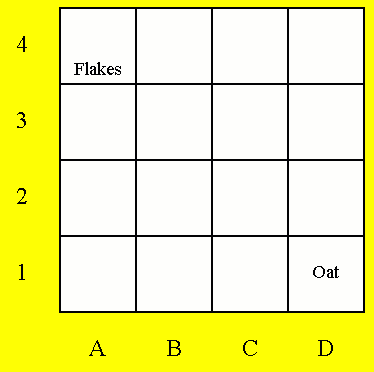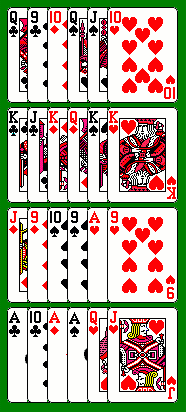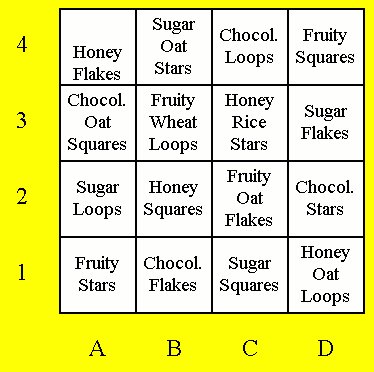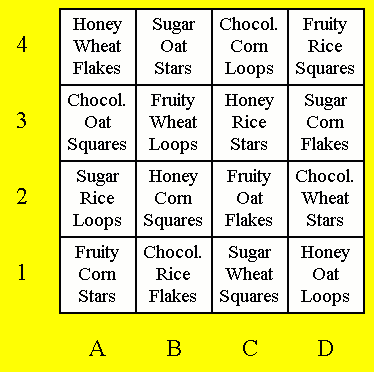
Solutions to Logic Problems by Michael
Keller
Euchre
Joe held a black jack (clue 2) but not the jack of clubs (clue 3), so he
held the jack of spades and nine of clubs (clue 2). He also held the
ten of hearts and ten of diamonds (clue 5). We have identified four of his six cards, so he
cannot be Blackwood, who held four kings (clue 4), so Joe is Cavendish and David is
Blackwood, (clue 4). Joe also held the queen of spades and queen of clubs (clue 4), so we have
identified all six of his cards. Bob is not Foster (clue 6), so Bob is Phillips and Harry
is Foster. David held the four kings (clue 4) and the jack of clubs (clue 3). He also
held the queen of diamonds, since it was not held by Bob or Harry (clue 6), or Joe, whose
six cards we already know. Bob held the queen of hearts (clue 4), jack of hearts
(clue 3), and the three aces (spades, diamonds, clubs) not held by Harry (clue 4), so he
also held the ten of clubs (clue 1). Harry held the ace of hearts (clue 4) and the
remaining unnamed cards (jack of diamonds, ten of spades, nine of diamonds, nine of hearts,
nine of spades).

| Igor | Kuznetsov | ||
| Kuznetsov | Moscow | ||
| Kuznetsov | Ruy Lopez | ||
| Igor | Moscow | ||
| Igor | Ruy Lopez | ||
| Dmitri | Sergeev | Moscow | Ruy Lopez |
Do we know who plays who yet?
Igor
Kuznetsov cannot
play any of the other players named Igor or Kuznetsov (clue 5), so he
plays Dmitri.
The Kuznetsov from Moscow plays the player named Igor who prefers the
Ruy Lopez, and vice
versa. From clue 2, we know that Igor Kuznetsov prefers
the French, and is
not from Omsk. He isn't from Volgograd either (clue 3), so he is
from St.
Petersburg. Let's pair up the players and add what we know:
| Igor | Kuznetsov | St. Petersburg | French |
|
Dmitri |
Sergeev | Moscow | Ruy Lopez |
| Kuznetsov | Ruy Lopez | ||
| Igor | Moscow | ||
| Igor | Ruy Lopez | ||
| Kuznetsov | Moscow |
Pavel is the Kuznetsov from Moscow, since
he prefers
the
Nimzo-Indian (clue 6). By elimination, Igor from Moscow prefers
the Sicilian (and
is Alexandrov, since he is not Petrov from clue 3). His opponent
Kuznetsov is from
Volgograd (clue 3) -- and is Boris, by elimination. The player
from Omsk is Petrov,
by elimination. The full solution:
| Igor | Kuznetsov | St. Petersburg | French |
| Dmitri | Sergeev | Moscow | Ruy Lopez |
| Boris | Kuznetsov | Volgograd | Ruy Lopez |
| Igor | Alexandrov | Moscow | Sicilian |
| Igor | Petrov | Omsk | Ruy Lopez |
| Pavel | Kuznetsov | Moscow | Nimzo-Indian |
Igor Kuznetsov played Dmitri Sergeev, Boris Kuznetsov played Igor Alexandrov, and Igor Petrov played Pavel Kuznetsov.
Cereal Display

The grid above is labeled to make the solution easier to follow.
Sugar Oat Stars are on the top shelf (clue 1). Oat flakes are not on the bottom shelf (clue 4), so they are on the third shelf down (clue 8). Fruity Wheat Loops are on the second shelf down (clue 6), so the oat cereal on that shelf is oat squares, and the cereal at D1 is oat loops. Sugar Oat Stars are not at A4 (clue 7) nor B4 (clue 3), so they are at B4 or C4. Oat flakes are not at A2 or D2 (clue 3), so they are at B2 or C2, not aligned with Sugar Oat Stars. Oat Squares are therefore at A3 (clue 3), and they are Chocolate Oat Squares (clue 8). The oat loops at D1 are not fruit-flavored (clue 6), so they are honey (clue 5). The oat flakes are Fruity Oat Flakes (clue 5). The cereal directly above the Fruity Oat Flakes (at either B3 or C3) is not squares or loops, so it is stars. The cereal at D3 is therefore flakes, and neither chocolate, fruit-flavored, nor honey, so it is sugar. The cereal at C3 is rice (clue 2), so Fruity Wheat Loops are at B3 and Sugar Oat Stars at B4. Honey Rice Stars are at C3, and Fruity Oat Flakes are at C2. The rest of the shapes and flavors can be filled in using clues 3 and 5: for example, loop cereals are at A2 and C4, stars at A1 and D2, squares at B2, C1, and D4. Honey cereals are at A4 and B2, etc.

Now the wheat cereal in column A is not at A1 or A2 (clue 5), so it is at A4. The other wheat cereals are at C1 and D2. The cereal at C4 is corn (clue 3), and D4 is rice. The rest follows easily. The full solution:

This puzzle is an extended example of a Greco-Latin Square, an multiple arrangement of items so no element is repeated in the same row or column, and no two cells share more than one element in common. Another kind of puzzle based on Latin Squares is Mark Thompson's Latin Squares. Everett Kaser's site also has a good page on Mark's puzzle. The most famous puzzle based on Latin Squares is Sudoku, a somewhat simpler relative of Mark's game.
Portions of this article previously
appeared on the Games
Cafe
(www.gamescafe.com) in 2000; that site is no longer in operation.
This article is copyright ©2000, 2020 by
Michael Keller. All rights reserved.